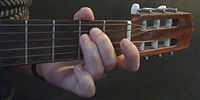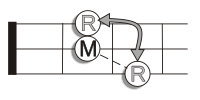Guitar/Jump between Em-D and Am-G
This page is currently being translated from Germans Wikibooks into English. • Expect some errors and inconsistencies. •Images has to be repainted. The German fingering ZMRK = imrp (Z = Index, K = small Finger = pinKy •Some German words in pictures has to be translated. • Assisted the translator because he is not a native speaker. Feel free to correct mistakes and style. • The Wikitorians among you may help me with the peculiarities of English Wikibooks. (how do you handle things, what are your preferd templates...). •delete {:Guitar/under construction - in translation}if you think the translation is largely error-free and good enough.• Be patient. The translation of the finished German lesson (links in the navigation) will take time. |
Original page translated by Google
Larger leaps between chords
and songs with more irregular chord progressions
[edit | edit source]Up to now, larger chord leaps have been avoided. There is always a risk that you will use up valuable time sorting your fingers.
The change between G and Am, as well as the change between Em and D should no longer cause any major problems, but it is a good idea to practise the slightly larger leaps in isolation before the first use. Songs that frequently feature slightly wider fingering changes can help with this.
There will always be chord progressions that you should practise in isolation before using them for the first time, until you can play them fluently.
Jump between G and Am
[edit | edit source]If you only practice individual chords, you quickly run the risk of always using the same method to build a chord, even though a different sequence would be more appropriate for a different chord progression.
Chords are not the most important thing you should learn, but the change from one chord to the next.
Jump between Em and D
[edit | edit source]Pay attention to the similarities
[edit | edit source]If you realize that this fingering changes are similar to the fingering change from A to D with which we started the course, then you've already gained a lot. Everything just happens a few strings higher.
For all 6 chords from the campfire diploma, there are practically only two positions for the ring and middle fingers.
"Bei D-Dur: 
|
"Bei A-Dur: 
|
The ring and middle fingers form a unit. We will rediscover this finger position for three more chords from the folk diploma, only the pitch varies.
After this lesson, the change between A major and G major should no longer cause any problems.
Chord degrees and the pop cadence
[edit | edit source]In the following songs, you may often notice the chord progression G D Em C. This is an I V VI IV chord progression. Chord degrees are usually represented in Roman numerals (1-5-6-4). In bands, the chord progression is sometimes called out as "a 15-64 in G", which also means nothing other than "a 1-5-6-4 chord progression in the key of G major".
The G major scale consists of the following notes:
- G A H C D E F# G
In an I V VI IV connection (1-5-6-4) in G major,
I - G is the 1st note in the G major scale and thus G is the 1st chord degree.
V - D is the 5th note in the G major scale and thus D is the 5th chord degree.
VI- E is the 6th note in the G major scale and thus Em is the 6th chord degree.
IV- C is the 4th note in the G major scale and thus C is the 4th chord degree.
This chord progression appears in so many pop songs that it is also called the "pop formula", "pop progression" or "pop cadence". So this is a chord progression that you should remember.
A few examples:
- Its not [G]time to make a [D]change, just re-[Em]lax and take it [C]easy (Father and Son)
- When [G]I find myself in [D]times of trouble, [Em]mother Mary [C]comes to me (Let it be)
- COUNTRY [G]ROADS take me [D]home to the [Em]place I be-[C]long
- [G]I won't hesi-[D]tate no more No [Em]more, it cannot [C]wait I’M YOURS
- And [G]I [D] - [Em] Will [C]Always Love [G]You
- [G]Never mind, I'll [D]find SOMEONE LIKE [Em] YOU [C] --
If a song is too low for you to sing, you can use a capo. This is explained in more detail in the Folk Diploma.
Listen to Axis of Awesome - 4 Four Chord Song to get an idea for the pop formula !
Irregular chord progressions
[edit | edit source]It may well be that you have already learned the previous chord changes. In this case, use the 7th and 8th lessons to practise songs with more complex chord progressions.
In the first lessons, we mostly preferred songs with a constant chord progression. Of course, this is not the case for all songs. There are also songs where you always have to look one or two chords ahead in order to know what happens next.
You can also practise songs where the quick chord change suddenly overtake you.
- Example "Take it easy"
- Well I'm a [G]runnin' down the road try'n to loosen my load I've got seven women [D]on my [C]mind
Beginners often stumble here because they can't yet hear the quick chord changes. If you don't have a songbook with notes or bar lines that draw your attention to such a quick chord change in the middle of the bar, then write brackets in the lyrics in pencil.
- Well I'm a [G]runnin' down the road try'n to loosen my load I've got [(]seven women [D][)]on my [C]mind
- Execution
- ...[(G]seven women [D][)]on my [C]mind
There is also no harm in practicing these lines separately with the corresponding cord changes until they are no longer a challenge.


















